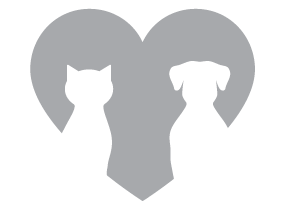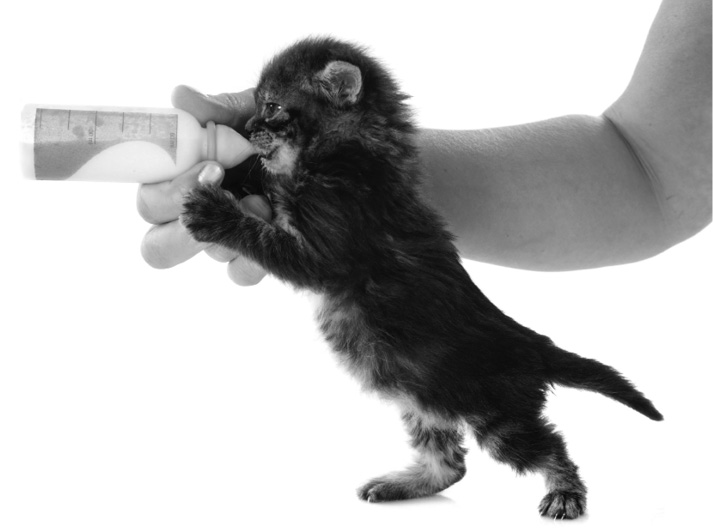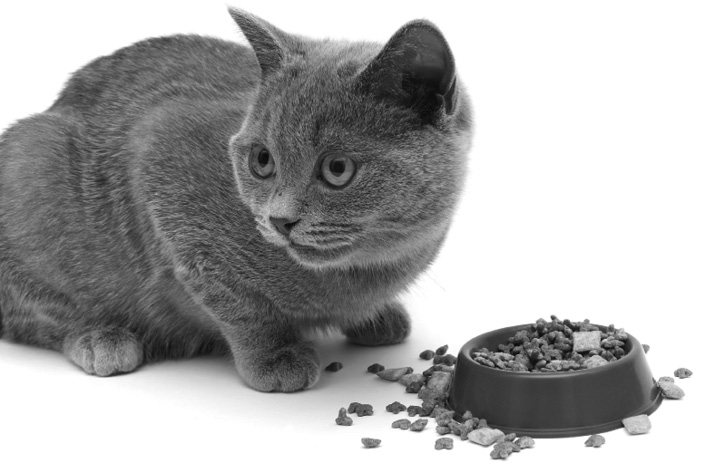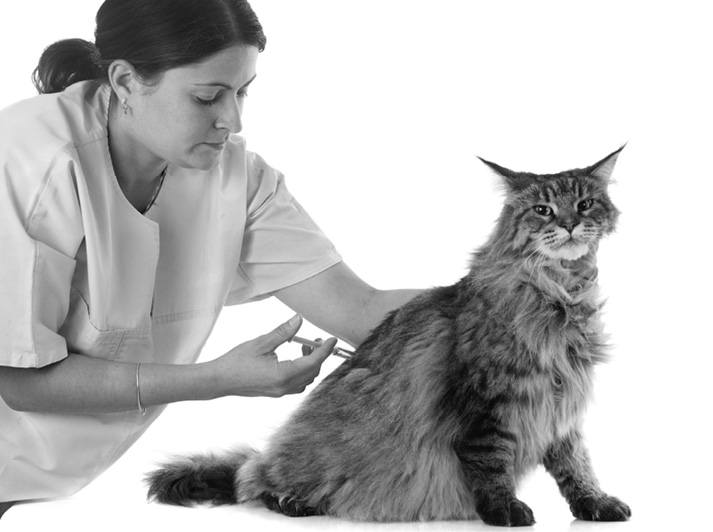
Chapter Ten:
Your Cat’s Dietary Needs,
from Birth to Old Age

You might think that feeding your cat is as simple as buying over-the-counter cat food and filling her bowl a few times a day, but there might be times where it is beneficial to spend a little time and effort in meeting your cat’s digestive and nutritional needs. This chapter is dedicated to reviewing what cats need from their diet and how you can make sure you cat’s digestive health is up to par.
One of the most important things you need to know about cat health is that cats are carnivores and therefore require much higher levels of dietary protein than dogs do — about five to six times more per pound of body weight (Shojai 2002). For that reason alone, you should not feed your cat your dog’s food. Read on for further explanations of what cats need to eat and how their digestive system works.
Feeding a Kitten
If you have a kitten in your life, your feline’s nutritional needs can change a lot in a very short period of time. Depending on the age of the kitten, she could need a diet of mother’s milk to specially designed kitten food. ASPCA nutrition experts recommend that newborn kittens receive a diet of mother’s milk for their first four weeks; if you find a kitten in that age range that cannot nurse from their mother, you can ask your veterinarian for recommendations regarding a commercial milk replacer.
A kitten’s weight may double or triple in their first few weeks and they expend large amounts of energy. When they are five or six weeks old, they might be ready for dry food, but it should be a kitten-formula designed specifically for their nutritional needs.
Kittens are often weaned and separated from their mother after eight weeks of age. If you acquire your kitten at this age, she should be ready for dry kitten food, but if she does not seem to take to it, experts recommend that you moisten the food with a commercial milk replacer to ease the transition.
According to the ASPCA’s website, kittens can be fed “free choice,” or in other words, when food is available at all times. Kittens can be fed dry food or nutrient-dense canned food; make sure there is always fresh water available to your little feline.
It is recommended that treats make up no more than 5 percent of your kitten’s daily nutrient intake.
Feeding an orphaned kitten
Kittens, like all infant mammals, will begin life consuming their mother’s milk. If you rescue a kitten that is still of age to nurse, but the mother is not around, remember that cow’s milk does not have the proper nutritious value to sustain that kitten. In fact, it can cause diarrhea even in adult cats (many cats are considered lactose intolerant).
You can usually find a pet nursing kit and kitten formula at your local pet store. If you come up empty-handed in that department, try contacting a few veterinarians until you can find what you need. A nursing kit should include a bottle, extra nipples and a cleaning brush. Cut an “X” in the tip of the nipple with scissors and use the bottle to feed your kitten formula such as KMR or Just Born. These products are more economically purchased in powdered form and you can mix as needed (http://kittenrescue.org).

Before each feeding, make sure you sterilize the bottle and nipples in boiling water. Formula should be served at room temperature and you should wash your hands before and after each feeding, protecting you and your kitten from each other’s germs. When it comes time to feed your kitten, open his mouth gently with your finger and put the nipple of the bottle inside. Once your kitten understands this is for food, he will search it out. If you have ever watched baby kittens at mealtime with their mother, you might have noticed that they get easily distracted. Do not pull the nipple away just because your kitten stops nursing for a few seconds; give him a chance to latch on and nurse more than once (http://kittenrescue.org).
Kitten’s nutritional needs
After your kitten nurses for several weeks, she will need to wean and start on a dry diet. When selecting your kitten’s meal, remember that she needs food that is “complete” and “balanced,” meaning that it contains all the necessary components (or nutrients) in the proper amount. The six different classes of nutrients for good kitten health include proteins, carbohydrates, fats, vitamins, minerals, and water (Shojai 2002). To examine them all in depth, read on:
Protein
The important thing to remember about proteins is that they can be found both in meat and other foods. Therefore, while meat is an important part of your kitten’s (and adult cat’s) diet, they need other sources of nutrition as well. Protein helps your kitten build a strong immune system as well as strong bones, tissues and muscles.
Carbohydrates
Your kittens do not need much in way of starches and grains, but carbohydrates do provide energy — something your kitten uses a lot of! They also help regulate your kitten’s bowels and enable her to easily absorb other nutrients. Be sure that whatever food you buy your kitten includes some carbohydrates.
Fats
Fat provides the food with a strong flavor as well as giving your kitten more energy to burn. It is important to disregard low-fat food when picking out your kitten’s diet.
Minerals and vitamins
Your kitten only needs small amounts of the necessary vitamins and minerals in his diet. Too much is as dangerous as too little, so be sure to check the labels of kitten food. Nutrients kittens need include calcium, phosphorus, magnesium, potassium, sodium and chloride, as well as vitamins C, A, D, E, K and B-complex (Shojai 2002).
Water and milk
Take care that you provide your kitten with a source of clean drinking water at all times. Just because your kitten was consuming mother’s milk not too long ago does not mean she can digest milk you buy from the store. Many cats actually react poorly to store-bought milk and you should avoid giving it to your kitten.
Wet vs. dry kitten food
When your kitten is just learning to eat solid food, a canned (or moist) diet might be perfect for her. As it turns out, canned kitten food is easily consumed by your little furry family member and often has high water content, helping keep your pet hydrated. Canned food is a more expensive food option and requires refrigeration once it is open. You might want to consider mixing a wet diet with dry food for cost savings.
Dry kitten food comes in bags, boxes, and other packaging that stores well. Dry kitten food can also be left out for the kittens to eat at will. Just make sure that your kitten is ready for a crunchy diet before you move them to dry food. If they do not seem to be doing well with dry food, consider using semi-moist food servings or combining wet and dry food together until your kitten is ready for an entirely dry diet (Shojai 2002).
NOTE: If your house is multi-generational and you have specialty food for both kittens and geriatric cats, you might need to take on a stricter dining plan for your cat family. You might need to feed your older cats in a room or space that the kittens cannot access. If you have a dog in the house, you probably won’t be able to leave the kitten food out all day long or you might have to take care to put it in a place where the kitten can get to it, but the dog cannot. I will cover specific recommendations on this matter later in this chapter.
Feeding an Adult Cat
The nutritional requirements for adult cats do not vary much from that of kittens, except perhaps that they need less food (calories) as they grow older. Remember that cats are unlikely to be able to live (or thrive) on a meat-free menu. Their dietary intake, as it relates to vegetables, is flexible. What is contained in dry cat food may be sufficient to meet their dietary needs. But at the very least, it is recommended that cats have access to grass as a source of certain vitamins. While a cat may vomit after eating grass, this might help them clean out their system of unwanted matter such as hairballs. However, be cautious not to expose your cat to chemicals or fertilizers that are used on some lawns (Edney 2006). A little pot of indoor grass might be a great way to address this issue.
According to the NRC National Academy of Sciences, cats nutritional needs break down as follows:
|
Component |
Daily Requirement |
Source |
|
Protein |
Up to 28 percent of their diet (kittens need much more).* |
Meat, fish, eggs, and cheese. |
|
Fat |
At least 9 percent. |
Animal and vegetable fats and oils. |
|
Carbohydrates |
Less than 40 percent. |
Rice, cereals, potatoes, dry cat food. |
|
Water |
50-70 ml. per kilogram of the cat’s body weight (basically as much as they want). |
Water should always be readily available. |
In addition to the basics detailed in the table above, cats need essential minerals and vitamins that are found in many manufactured cat foods. Be careful not to give supplements unless your veterinarian recommends it. Too much of some minerals and vitamins can be bad for your cat’s health.
*You should note that cats need 20 percent more protein in their diets than dogs. It is very important to their nutritional needs, so you should be sure any cat food you purchase has a high protein level (Edney 2006).
NOTE: If you have a pregnant or nursing cat (who — big surprise — is referred to as a queen!), she will need to consume more food than she otherwise would as a healthy adult cat. An average cat pregnancy lasts 65 to 69 days, but she will not really show her weight gain until the last few weeks of her term. You can feed her the same food she normally eats, but you might want to try to increase her protein intake when you can. Also, make sure she has food and water available to her regularly (there is no need for portion controls under the circumstances) (www.petmd.com).

Feeding an Older Cat
or a Cat With Health Concerns
Even if your cat shows no signs of aging, you might need to decrease his diet as he gets older. The ASPCA recommends starting your cat on a senior diet at about the age of seven. They say at this age, the main goal for your cat should be maintaining health and an ideal weight while slowing or preventing health issues or disease. According to the ASPCA, older cats may experience unhealthy skin, an unhealthy coat, loss of muscle mass, obesity, dental problems, intestinal problems and arthritis.
Feeding your cats a dietary plan designed for older felines can help prevent or delay age-related health concerns. In her article Feeding Your Senior Cat, Stephanie Watson states: “By the time a cat reaches his 12th birthday, he is the equivalent of a 64-year-old human. In their senior years, felines start to fall prey to many of the same ailments as we do” (Watson 2015).
Many older cat foods contain lower protein than regular cat kibble, but according to Kathryn Michel, Associate Professor of Nutrition at the University of Pennsylvania’s School of Veterinary Medicine, there is little research to prove that the nutritional needs of senior cats differ than that of younger adult cats (http://pets.webmd.com). But the needs of individual senior cats are not one-size-fits-all; they vary according to your cat’s specific health issues.
Obesity
As your cat ages and begins to slow down metabolically, your older cat might need to consume fewer calories to prevent obesity. As little as 10 calories per day over your cat’s dietary needs can translate to a pound of extra body weight over the course of a year (http://pets.webmd.com). That means that just a few extra treats can cause a serious weight concern over time. Make sure that as your cat slows down, you reduce her calories as well.
Diabetes
While diabetes can likely occur in cats of any age, it is definitely more prevalent in older cats and seems to be triggered most often by obesity. Many veterinarians recommend that cats with diabetes eat a high-protein, low-carb diet (Watson 2015). Diet can be used to control and stabilize blood sugar levels, making the condition easily manageable.
Kidney disease
Many cats develop kidney failure as they age. Older cats with this issue need to be on a phosphorous-restricted diet. These diets often have less salt and protein than standard cat foods (http://pets.webmd.com).
Other diseases
There are several other health problems that can restrict or change a cat’s diet. When a cat has cancer, they might be prone to heavy weight loss and may need additional calories to sustain their health. A cat with dental problems might not be able to chew dry food and will have to switch to an entirely wet diet. Be sure to consult your veterinarian on an ongoing basis to make sure you are achieving optimal nutrition as your cat ages or has special heath concerns.
Avoiding an Overweight Cat
The “fat cat” is such a common place stereotype that the health risks of an obese cat are likely overlooked these days. However, the negative effect of a cat carrying too much weight is nothing to overlook. Carrying too much weight can be detrimental to your cat’s heath, with potential risks ranging from stress to the body, an increased risk of diabetes, possible liver problems and potential joint pain. Earlier, I reported that the APOP classifies 58 percent of all cats as overweight or obese. That means most cat owners need to consider if their cat weighs more than they should and identify what they can do to correct the issue.
The cause of obesity in cats is typically more than simply overeating. If your cat is inactive and consumes a high amount of calories (i.e. when energy intake exceeds the cat’s daily requirements), food will begin to be stored as fat. The key to avoiding this situation is two-fold: do not overfeed you cat and make sure she remains active. How do you know if your cat is overweight? Ask your veterinarian to provide you with some insight on your cat’s weight and what his or her goal weight should be. A rough guideline by breed is listed below:
Ideal Weights of Cat Types
(http://petobesityprevention.org)
|
Domestic Cat |
8 to 10 pounds |
|
Persian |
7 to 12 pounds |
|
Siamese |
5 to 10 pounds |
|
Maine Coon |
10 to 25 pounds |
Other ways to measure that your feline is at a healthy weight is to give her a good rub down. According to the ASPCA, you should be able to feel your cat’s backbone and ribs. You should also be able to notice a waist between the back of your cat’s rib cage and her hips when looking at her from above. If you cat does not seem to pass these visual standards, you might want to ask your veterinarian to recommend a special diet.
Once you consult your cat’s vet to determine his or her proper caloric requirements, you can develop a feeding schedule that ensures your cat does not over consume. You can also work to increase your cat’s activity levels.
The associated risk of an overweight cat is not dissimilar to that of humans; they include diabetes, high blood pressure, heart and respiratory disease, ligament injury, kidney disease and up to a five-year decrease in life expectancy (according to ASPCA, the average lifespan of an indoor cat is between 13 and 17 years).
One thing to remember about cats is that they have a unique metabolism that can produce “hepatic lipidosis” (also known as fatty liver) if they do not receive an adequate amount of food. In most animals, when the body is undernourished or even starved, the body starts moving fat from its reserve cells to the liver to be converted into lipoproteins for energy. Cats’ bodies are not designed that way; therefore, when a cat is forced into starvation mode, the fat that is released to the liver is not processed properly and creates a low functioning liver (http://pets.webmd.com) and eventually severe liver disease that can lead to death.
Therefore, if you start to believe your cat is overweight and needs to drop some pounds, try to remember that you cannot just severely cut back on her food portions. Switching to a lower calorie diet and a feeding strategy that limits her time for eating might be effective ways to lower her weight in a healthy way. But do not try to put her on a crash diet as that will clearly have adverse effects on her health.
Just like in humans, weight loss should be gradual and occur over time. If your cat suddenly drops a significant amount of weight, that could be a sign of illness or disease. Even if she was once considered overweight or obese, do not automatically consider drastic weight loss as a victory. Consult your veterinarian and make sure there is nothing negative driving your cat’s body change.
